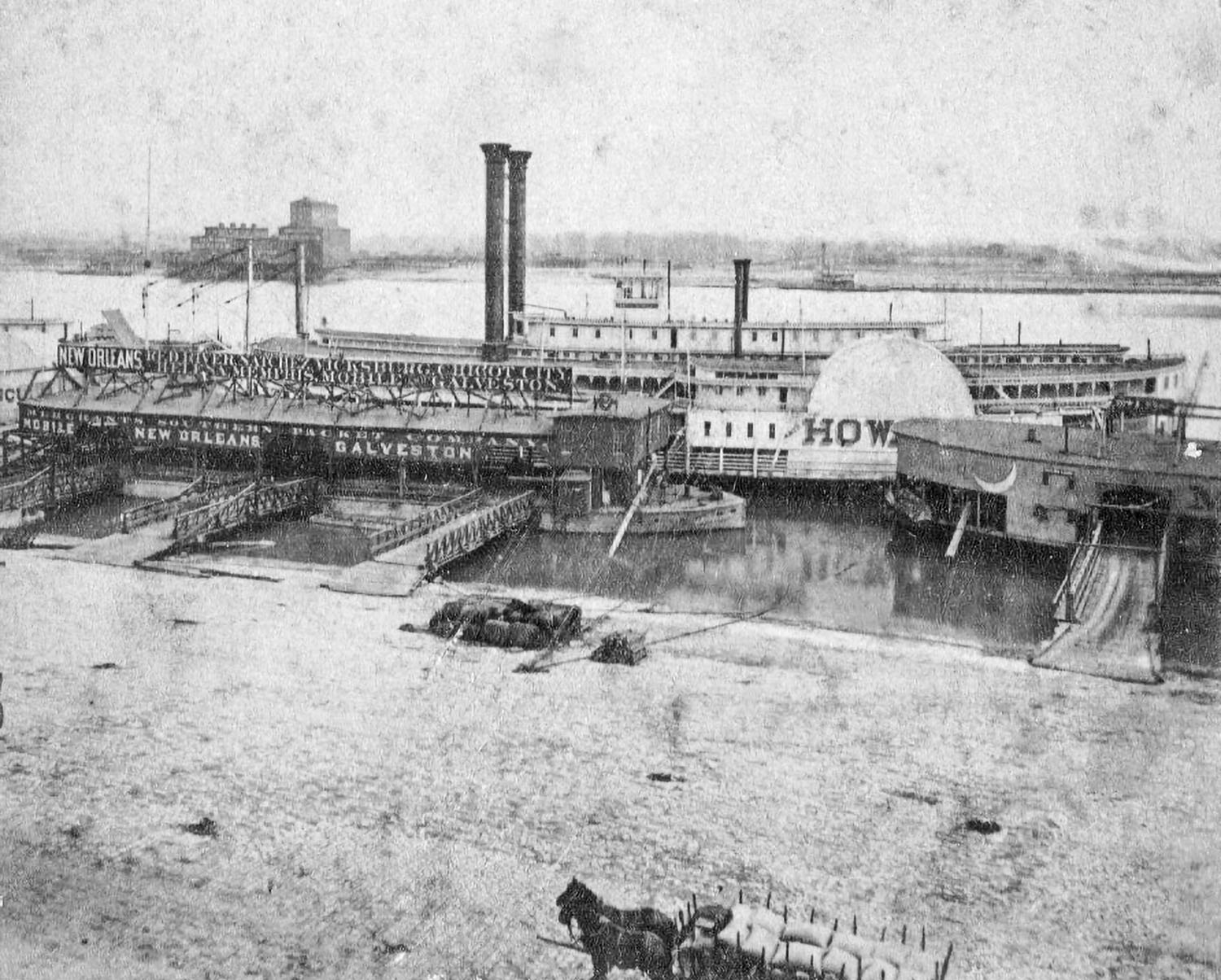A recent acquisition to the writer’s collection is this week’s Old Boat Column image of the packet James Howard alongside a wharfboat at the St. Louis levee.
In 1870, Capt. B. Rush Pegram ordered, from the famed Howard Shipyards, at Jeffersonville, Ind., a leviathan sidewheeler, the wooden hull measuring 320 feet in length by 53 feet in width, and with a 10-foot depth. The overall length of the riverboat was 328 feet, and it was designed to carry 3,200 tons. Pegram named the vast vessel James Howard in tribute to the famous steamboat builder.
Six four-flue boilers, each 46 inches by 30 feet in length, supplied steam to engines having 34-5/8 inch cylinders with a 10-foot stroke. The side paddlewheels were 39 feet in diameter, working 16-foot bucket planks. The overall height of the Howard, from the waterline to the iron feathers atop the towering smokestacks, was 104 feet.
The steamboat was constructed for the St. Louis–New Orleans trade and cost $180,000. The new riverboat was taken to Cincinnati where, on January 21, 1871, it was opened for public inspection. Reportedly, some 45,000 visitors came aboard, crossing over one gangplank and, after touring the cabins and decks, exiting by another in order to facilitate crowd control. In early 1872, the boat transported Grand Duke Alexis Aleksandropovich of Russia and his entourage to New Orleans in time to attend the Mardi Gras.
Masters who served aboard the James Howard (roustabouts affectionately called the boat the “Oil Cake Jim”) were Capt. Rush Pegram, Capt. James O’Neal, Capt. James Pepper and Capt. Joseph Bryant.
At 1 p.m. September 9, 1873, as the boat was arriving at the Upper Mississippi River community of Commerce, Mo., fire was discovered in the hold. Rather than battle the blaze, the captain decided to scuttle the boat. Extremely close to shore, the water was found to be too shallow to extinguish the fire. The quick-acting crew pumped the vessel back afloat, moved it to deeper water and again scuttled the burning boat. This second attempt sank the Howard below the guards, successfully dousing the conflagration. Although this operation sounds somewhat preposterous, accounts of it were carried in many newspapers.
The biggest cotton cargo carried by the James Howard was 7,701 bales, a record to that time, handled in 1875. It was said that “Uncle Jim” Howard was justifiably proud of the big boat that bore his name, painted in fancy block lettering eight feet in height and stretching 70 feet in length on the wheel boxes.
James Howard died tragically (at age 61) in the autumn of 1876 as the result of his horse and carriage rolling overboard from a ferryboat in the Louisville harbor. This freak accident was the subject of a WJ Old Boat Column, issue of October 19, 2015.
Capt. Pegram sold the big boat to the St. Louis & New Orleans Anchor Line in 1878. On March 13, 1881, the Howard arrived at the St. Louis levee, fresh from a New Orleans trip with a large cargo of sugar. The lines had hardly been tied to the wharf when fire broke out on the main deck. All passengers and crew members were safely evacuated, but the James Howard, considered to be one of the greatest steamboats of all time, was rapidly consumed by the blaze and was a total loss.
Caption for photo: The James Howard at a St. Louis wharfboat in the 1870s. (Keith Norrington collection)




